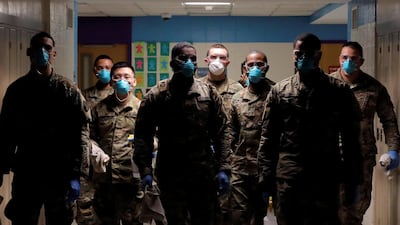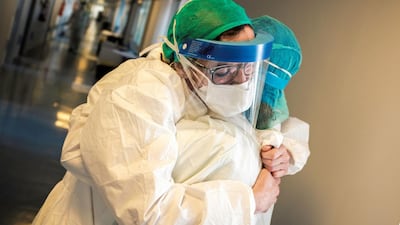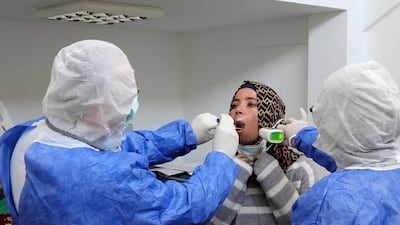As the scramble to develop a vaccine for the novel coronavirus continues amid an escalating worldwide pandemic, scientists are trying to better understand how the pathogen spreads.
Learning how it is passed on – and what can be done to prevent transmission – is crucial to limiting the global death toll, which now exceeds 13,000. On Friday, the UAE recorded its first fatalities.
“We do not fully understand how it’s being transmitted, but it’s probably just as contagious or more so than some of the other respiratory viruses,” said Dr Andrew Freedman, a reader in infectious diseases and honorary consultant physician at Cardiff University in the UK.
The ease of spread is measured by a figure called R0 (R nought), which indicates how many people an infected person is likely to pass a virus to.
Influenza has an R0 value of about 1.3, while for the novel coronavirus, the figure is between two and three. Some viruses are much more easily transmitted: the one that causes measles has an R0 of between 12 and 18.
Much medical interest centres on the length of time in which the virus remains infectious in the environment.
Some human coronaviruses can live for up to nine days on inanimate surfaces, although their ability to infect sharply decreases over this time.
The coronavirus that causes the Covid-19 disease is less robust; it is not infectious on plastic or steel after 72 hours.
On more porous surfaces, such as cardboard, it remains alive for about 24 hours, so any theoretical risk from parcels is reduced to zero a day after they have been delivered. On copper the virus lasts only four hours.
Scientists in the United States once reported that five seconds of contact with a contaminated surface leads to almost one third of influenza A virus particles being transferred to hands, but no similar data on how easy it is to pick up Covid-19 is available.
What is known about the new virus, however, is that that people can pick up enough from surfaces to be infected.
Notably, several people in Hong Kong developed Covid-19 after attending a Buddhist temple at which taps and cloth book covers were contaminated.
Once people have enough of the virus stuck on their hands, they can easily infect themselves by touching their eyes, nose or mouth, though it is not known for certain how many hours the virus could last on skin.
In 2015 research, medical students in Australia were found to touch their faces 23 times per hour, on average, with the mouth, nose and eyes being the most commonly touched areas, after their skin.
“Hand sanitiser means you can reduce the risk of picking it up from surfaces and giving it to yourself,” said Professor Paul Digard, a professor of virology at the University of Edinburgh in the UK.
Human coronaviruses on surfaces can be destroyed within a minute by disinfectants, such as those containing alcohol or hydrogen peroxide.
Little is known about how well the virus that causes Covid-19 stays on human skin, although natural oils might work against it. For comparison, rhinoviruses, types of which cause the common cold, can remain active for hours on human skin.
While contaminated surfaces and hands are one infection route, there is also the risk of direct person-to-person spread.
Novel coronavirus particles can remain suspended in the air for up to half an hour, but the concentrations are not thought to be enough for transmission unless an infected person is still around.
Prof Digard said it was unlikely the novel coronavirus could be transmitted simply by breathing.
“A truly airborne virus like measles, I don’t think it’s like that. This thing is probably spread by larger droplets, by somebody coughing or sneezing,” he said.
Closer proximity to an infected person, and spending more time near them, increases the risk. The recommendation is to remain about two metres away from others.
The novel coronavirus is also present in faeces, which can cause transmission through contamination of water and surfaces. Disinfecting surfaces, washing hands and boiling water can prevent this.















